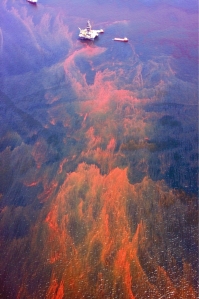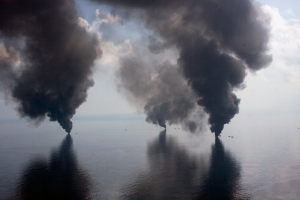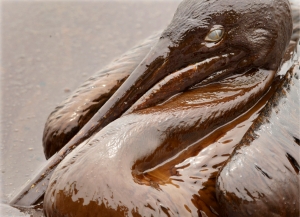 photo by John Wathen
photo by John Wathen
A week after the BP Deepwater Horizon oil disaster in April 2010, Alabama photojournalist John Wathen contracted a plane, grabbed his camera, and began filming. On a visit to Dunedin he described that disaster as it is still unfolding, three years later. He showed the black smoke four and a half thousand feet in the air as they burned off the oil. He showed how the sea changed to a brightly rainbow-coloured oil soup, then, weeks later, deep reddish purple. He described the death of birds, whales, dolphins and fish, respiratory and skin illnesses in people, destruction of livelihoods and of the environment on a massive scale.
The summer after the event, authorities covered the beaches with pristine white sand to make them look normal for the tourists. But the sea wasn’t safe. One of those tourists, a healthy young marine, swam in the sea and now has lesions on his brain and suffers constant siezures. People who swim in the Gulf, even now, get lesions that won’t heal. John has scars on his own arm from sores that took over a year to heal.
 photo by John Wathen
photo by John Wathen
The food is contaminated, but if the fishermen don’t fish the State calls it voluntary abandonment of livelihood, so there is no compensation. There’s not much left. John showed a picture of a shrimp (prawn) born with no eye sockets.
He showed a sperm whale soon after the disaster, lying in the oily water, blood streaming from its blowhole. He showed a young dolphin washed up on the beach three years and three generations after the disaster, unnaturally small, its own mother genetically damaged after its grandmother ingested Corexit.
Corexit is a dispersant, a by-product of oil refining and manufactured by the oil companies, that was used in vast quantities after Horizon to try to disperse the oil. It broke the oil into tiny particles that sunk and then dispersed more widely into the environment. The dispersant was absorbed through the skin and ingested by the marine life. It entered the hydrologic cycle, evaporated into clouds and fell as rain.
The huge quantities of reflective oil created its own new weather pattern, with cumulous that normally forms over land piling up at sea and being carried and dropped onto the southern US.
John described the fate of his vegetable garden; corn that wouldn’t grow, beans like rubber – nothing was edible. He said entire marshlands died overnight when the Corexit fell as rain. He described how dolphins and other creatures, instinctively trying to reach their breeding grounds, swam straight into the oil. Those that were saved went straight back.
 photo by PJ Hahn
photo by PJ Hahn
It feels uncaring to talk in dollar terms after hearing John’s story, but the cost of this disaster to Americans is $80 billion and rising.
Why don’t we hear about this? Is it partly because BP spent $50 million on their public relations post Horizon strategy?
John Wathen was here to warn us. He said his trip to NZ, sponsored by Greenpeace, has been part of his healing process; that if he can alert people to what happened in his homeland and help prevent it happening elsewhere, then something good can come of this tragedy.
John Wathen’s visit is timely
It is over seventy years since Shell drilled the first commercially viable offshore oil well in the Gulf of Mexico. Today there are over 4,000 wells, many of which leak oil daily. Our first southern ocean exploration well is due this coming summer. Anadarko Petroleum Corporation, a quarter owner of the Deepwater Horizon rig, plan to drill 60km off the Dunedin coast.
The Horizon rig was 66km from the Louisiana coast when it blew.
About 150 km out from Dunedin, in the Great South Basin (GSB), Shell New Zealand is planning to drill down to about 4km in 1.5km deep water soon.
The Deepwater Horizon rig was situated in the relatively calm waters in the Gulf. Hundreds of vessels were nearby to help as soon as disaster struck. Anadarko and Shell’s planned wells would be in areas as remote, and in seas as rough, as any on the planet. Help would be weeks, months away.
In October 2011 New Zealanders witnessed the unpreparedness of our maritime safety system after the Rena capsized off the coast of Tauranga. Maritime New Zealand sprayed six hundred litres per flight of Corexit on to the fast growing oil slick before abandoning the practice after a few weeks. This, New Zealand’s worst maritime disaster so far, was tiny compared to other oil spills that happen daily around the world. The Montara blowout off Perth in 2009 spilled the equivalent of one Rena disaster per day for 74 days into the Timor Sea. Around 64,000 hectares of coral reefs were destroyed.
New Zealand is a tiny country. Such a spill in our southern ocean would, with the prevailing currents, reach the entire eastern coast of the South Island.
Rena has cost taxpayers $36.8 million. Meanwhile, the government has a $10 million cap on what oil companies have to pay if a disaster occurred. A tax exemption on profits of non-resident operators of offshore rigs and seismic vessels has been extended until the end of 2014. Beyond 12 km there is no requirement for them to produce ESHIAs (Environmental, Social and Health Impact Assessment) and there is no industry bond to cover liability. Taxpayers have spent $25 million upgrading NIWA’s Tangaroa, enabling it to sell seismic surveys to the oil industry.
Local bodies and communities have no say as to whether or not companies drill in our oceans, and rarely, in these times of 20 second sound bites, do stories like John Wathens’ get heard by the wider community. But it is stories like this one that should be part of the mix when decisions are made about deep sea oil drilling in New Zealand. We need to be given the facts, see beyond the public relations spin, and understand the risks.
Actually the photo of the oiled Pelican was not my shot. I got it from PJ Hahn, another great Gulf warrior journalist. The rest are mine. This story is real and still effecting our communities even today. Thanks for keeping this alive. If we can help stop this in any way just ask.